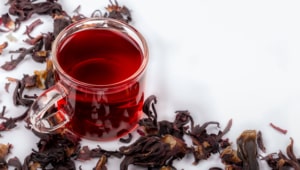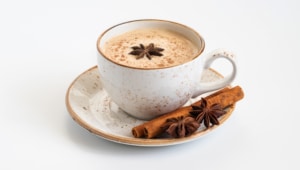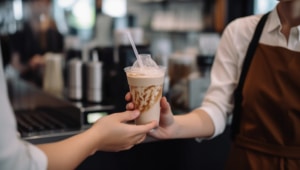7 Health Benefits of Oolong Tea & 3 Serving Tips
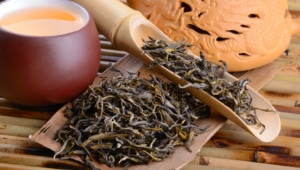
Oolong tea has a lovely origin myth, whereby a man called Wu Liang (this later became Oolong) was picking tea leaves. Read on to learn everything about the health benefits of Oolong tea, plus tasty hacks and tips.
You may be wondering how oolong tea differs from regular black tea — the simple answer is that it’s only partially oxidized. Oolong’s flavors range from floral and grassy to toasty and sweet.
It’s a popular tea in Southern China, where it’s used as part of the Gongfu Tea Ceremony. There are many different flavor varieties, and a good range of health benefits.
Oolong tea lies somewhere between green and black teas, and it’s well worth exploring if you already love those types of tea.
Interesting Facts about Oolong Tea: The Traditional Chinese Tea

Interesting Facts about Oolong Tea: The Traditional Chinese Tea
Oolong tea is semi-oxidized, meaning it’s ‘aged’ to different levels. Because of this, oolong can vary greatly in flavor and strength. It’s originally from China and Taiwan.
The fermentation process used to create oolong gives it a unique milky, toasty, yet floral flavor that’s popular amongst tea connoisseurs everywhere.
Origin and Where Oolong Tea Comes From

Origin and Where Oolong Tea Comes From
Fragrant oolong tea originated many centuries ago during the Ming Dynasty (around 1368-1644).
Depending on who you ask, the name either derives from a myth surrounding a man called Wu Liang, or the Chinese words ‘wu long’, which translate to black dragon.
As such, oolong was also once known as ‘black dragon tea.’ It’s particularly popular in Southern China and Southeast Asia.
What Oolong Tea Is Made Of

What Oolong Tea Is Made Of
As with other popular tea types, oolong is made chiefly from leaves of the camellia sinensis plant.
Oolong is a kind of in-between variety of black and green tea, as it’s fermented much longer than green tea, but less than the stronger, more oxidized black tea.
Oolong is a caffeinated tea, contains plenty of antioxidants, and is available in a variety of interesting flavors thanks to its unique fermentation process.
What Oolong Tastes Like

What Oolong Tastes Like
Oolong tea tastes like a hybrid between green and black tea, minus the slightly bitter notes green tea can sometimes possess. It’s toasty, sweet, and a little floral, and can sometimes have a little smokiness.
This tea tastes fresh, bright, yet nutty, and rich. Depending on who you ask, oolong is recommended to be enjoyed on its own to really savor its complex flavors, or with milk for an enjoyable, relaxing beverage.
It also makes a great base for boba tea, with the many added health benefits this particular tea has to offer.
Oolong Tea Versus Green Tea

Green Tea Versus Oolong Tea
Oolong and green teas are similar in several ways: they’re both made from the leaves of the same camellia sinensis plant. They both contain a range of vitamins, minerals, and antioxidants.
They both contain caffeine. With that said, the similarities end there. Oolong tea contains more beneficial antioxidants, though green tea contains less caffeine.
Oolong tastes more toasty, nutty, and sweet, while green tea tends to have a grassier, earthy, and almost citrusy flavor.
Interestingly, it also shares similar qualities with black tea, though it contains less caffeine than its more thoroughly oxidized cousin. If you already enjoy green and black teas, oolong tea is well worth adding to your tea exploration repertoire.
Nutritional Facts and Calories of Oolong Tea

Nutritional Facts and Calories of Oolong Tea
Oolong tea contains traces of vitamins and minerals, including calcium, potassium, magnesium, manganese, and phosphorus.
Oolong tea also contains a tiny amount of myo-inositol, and plenty of antioxidants such as polyphenols, which are particularly good for weight loss and overall health.
Interestingly, oolong tea also only contains around 2.4 calories per cup. So it’s a mildly nutritious beverage that won’t affect any weight loss journey you may be on either.
Health Benefits of Drinking Oolong Tea

Health Benefits of Drinking Oolong Tea
This delicious tea offers a variety of health benefits. Since it lies somewhere between green and black tea varieties, it also has health effects between the two. Here are some of the top reasons you might wish to add oolong tea to your diet.
May Contribute to Healthy Weight Loss

May Contribute to Healthy Weight Loss
Oolong tea helps speed up your metabolism, which in turn aids weight loss.
One study even theorized that oolong tea can help your body burn more calories than it would without drinking it.
The caffeine in this tea may also give you a little extra kick to boost your energy levels, making it more likely you’ll stick to any exercise regimen.
Fights Illnesses by Supporting Your Immune System

Fights Illnesses by Supporting Your Immune System
Oolong tea helps your body fight illnesses by supporting your immune system. It does this because of the high content of antioxidants.
These help reduce any inflammation in your body, as well as neutralizing free radicals. The latter could cause damage to your cells — getting rid of them prevents this from happening, keeping you healthier.
Reduces Risks of Some Diseases and Heart Disease

Reduces Risks of Some Diseases and Heart Disease
The antioxidants in oolong tea help with the fighting of illnesses, which includes certain heart conditions, diabetes, and some cancers. One study suggested that consuming plenty of oolong tea regularly could reduce your risk of developing breast cancer by a whopping 25 to 50 percent.
Aids in Balancing Your Blood Sugar Levels

Aids in Balancing Your Blood Sugar Levels
Adding oolong tea to your diet may help people with type 2 diabetes in reducing their blood sugar levels. The potential benefits look promising, thanks to the presence of polyphenols and caffeine.
On the other hand, the caffeine levels could possibly make controlling of blood sugar levels more complicated.
If you’re looking to add oolong tea to your diet as part of better blood sugar control, you’ll probably want to speak to your doctor first.
Filled with Beneficial Antioxidants

Filled with Beneficial Antioxidants
As noted above, oolong tea is filled with beneficial antioxidants. These include theaflavins, thearubigins, and EGCG. The latter is also present in green and black tea.
Green tea has slightly more EGCG than oolong, and oolong slightly more than black tea, as it’s lost during the tea’s processing.
Some of the benefits of EGCG alone include the prevention of cellular damage, lowering of disease risks, regulation of blood sugar levels, aiding weight loss, and more.
Contains Useful Amino Acids

Contains Useful Amino Acids
L-theanine, an amino acid found in oolong tea, is known to be beneficial for the relief of anxiety. If you’re feeling particularly stressed or overwhelmed, enjoying some oolong tea can be helpful.
Just make sure you have your tea earlier in the day, as a nighttime cup can encourage wakefulness due to the tea’s caffeine content.
Making Tea Can Enhance Your Wellbeing

Making Tea Can Enhance Your Wellbeing
Lastly, just adding a tea ‘ritual’ of some sort to your day can enhance your wellbeing in a positive way. The idea is that making your tea encourages a small moment of stillness, mindfulness, and connection with yourself.
Just taking the time out to steep your oolong tea, and enjoy its scents and flavors can give you a moment to breathe and relax.
Potential Risks of Oolong Tea

Potential Risks of Oolong Tea
You’ll be pleased to find out that oolong tea doesn’t have a lot of adverse effects or potential risks. It’s mostly just a mild, delicious tea with plenty of health benefits. Most people can enjoy oolong tea risk-free.
Caffeine May Adversely Affect Some

Caffeine May Adversely Affect Some
A typical 8 fl oz cup of oolong tea will contain on average 50 to 75 milligrams of caffeine. That’s a little more than green tea, but less than black tea, and a lot less than coffee.
A cup of brewed coffee typically contains around 70 to 140 milligrams of caffeine. Too much caffeine can exacerbate certain nervous conditions, adversely affect heart health, and isn’t advised in pregnancy.
The key takeaway here is ‘too much’ — if you stick to the recommended levels, you’ll be just fine. If in doubt, speak to your doctor.
High Amounts of EGCG May Cause Liver Damage

High Amounts of EGCG May Cause Liver Damage
Since oolong tea contains a relatively high amount of the antioxidant EGCG, it’s worth noting that overconsumption can cause problems. Having too much is linked to liver damage.
Having very large quantities of oolong or green teas is therefore not recommended for people who already suffer from liver disease, pregnant women, and those suffering from kidney failure.
With that said, the maximum recommended supplemental dose of EGCG is 800mg — oolong tea contains around 68 mg per 300 ml of tea. So you’d have to drink around 12 very large cups per day to have any concerns.
Is Oolong Tea in Pregnancy Good For You?

Is Oolong Tea in Pregnancy Good For You?
Oolong tea is perfectly fine to consume in pregnancy, so long as you do it in moderation. You typically shouldn’t have more than 200 mg of caffeine per day when pregnant.
As a typical cup of oolong tea contains around 63 mg of caffeine, you can enjoy at least one cup per day without any concerns.
Better yet, the antioxidants and amino acids in oolong tea are beneficial for avoiding illnesses during pregnancy, may help balance your blood sugar levels, and can even lower any feelings of stress or anxiety.
This makes oolong tea a good choice for moms suffering from gestational diabetes, too.
Lastly, oolong tea contains more caffeine than green tea but less than black tea or coffee. This makes it a good alternative if you really crave your caffeine, but don’t want to have anything stronger.
Simple Guide for Making the Perfect Oolong Tea

Simple Guide for Making the Perfect Oolong Tea
The perfect cup of fragrant oolong tea may be up for debate: some enjoy it with sugar, some with milk, some just plain to really savor the many different flavor notes of this special tea.
With that said, if you’ve ever had boba, or bubble tea, you’ll really love this recipe for the best ever oolong boba. You can even modify it to include your favorite type of milk — whether that’s dairy milk or a plant-based alternative of your choice.
Ingredients:
- 1 cup of oolong tea
- ½ cup of quick-cooking tapioca pearls
- 2 tbsps of brown sugar
- 1 cup of whole milk
- 1 cup of ice cubes
And here’s how you do it:
- Prepare a cup of oolong tea. Allow it to steep for 2-3 minutes before letting your tea cool to room temperature.
- Boil the tapioca pearls per the package instructions. Once they’ve reached your preferred consistency, drain them, but reserve a few tablespoons of the hot water.
- Mix the sugar into the remaining hot water until dissolved.
- Add the tapioca balls and ice cubes to two tall glasses. Pour the sugar syrup evenly over the tapioca.
- Add the cooled tea and cold milk, stir, and enjoy.
Tips for Drinking and Serving Oolong Tea

Tips for Drinking and Serving Oolong Tea
Oolong tea offers a variety of different flavors on its own. This is largely due to the way it’s processed. If you want to enjoy your oolong a little differently, below are some alternative options.
Add Fresh Fruit for Some Sweetness

Add Fresh Fruit for Some Sweetness
Oolong tea pairs very well with a variety of fresh fruit. You could add these on their own or alongside honey for extra sweetness.
Some of the best fruits to add to your tea include citrus, cherries, berries, plums, apples, or peaches. The best way to do this is to steep the fruit in cooled oolong tea to make a homemade fruit iced tea.
Make Your Own Boba Tea at Home

Make Your Own Boba Tea at Home
If you’ve never had boba before, you’ve definitely been missing out. Boba or bubble tea originated in Taiwan in the 1980s, and has been popular worldwide ever since.
You can make your own oolong bubble tea at home by following our simple recipe above. A word of warning: you won’t be able to have just one of these.
Enjoy an Oolong Tea Latte (Iced or Hot)
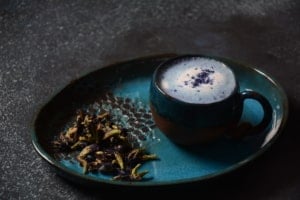
Enjoy an Oolong Tea Latte (Iced or Hot)
Oolong latte is best made similar to our boba tea recipe above — just minus the tapioca pearls.
You can make your oolong tea latte hot or cold, and enjoy it with dairy milk or a plant-based variety of your choice. Oolong tea makes for a tasty, less-caffeinated alternative to coffee-based lattes.
- Chai Tea. Health Benefits and Hacks.
- Raspberry Leaf Tea. Tips, Hacks and Health Benefits.
- Starbucks Refresher. Tips and Best Drinks.
- Jelly Belly Flavors. Best and Grossest.
- Boba Flavors. Best Flavors and Types.
- Pop Tart Flavors. Tasty Alternatives and Best Flavors.
- Cinnamon Tea. Health Benefits and Tips.

